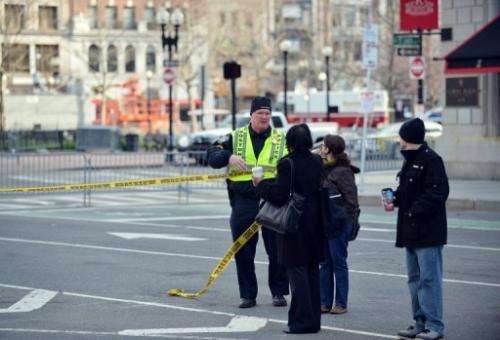Investigators pursue digital clues in Boston bombings (Update)

Investigators pored over hours of video and thousands of photos Tuesday in a scramble for digital clues to the Boston marathon bombing.
They appealed to the public to come forward with any images that may have been taken in the minutes before and after the twin blasts that killed three people, including an eight-year-old boy, and injured more than 170.
"Photos taken close to the blasts, just before, just after... Those will be critical, and we'll prioritize those," Boston Police Commissioner Ed Davis told reporters.
"Give us the photos and as much information (as possible) that can help the investigators move forward."
Countless such images went up on social media platforms such as Facebook and Twitter in the minutes and hours after Monday's attack.
Others emerged Tuesday, including one sent to local television station WHDH by a viewer that may have captured the second explosive device.
"In the first picture you can see a bag next to a mailbox and up against a barricade along the marathon route," said WHDH on its website, where it posted the images after sharing them with the FBI.
"In the second, which we have blurred because it is very graphic, there is no sign of the bag. The viewer who took the pictures says there may be an hour or more between when the first and second pictures were taken."
Investigators suspect the bombs were fashioned out of pressure cookers likely filled with ball bearings, nails or other shrapnel-like materiel, then stuffed into dark-colored nylon backpacks.
Davis urged members of the public who submit images "to tell us what time those photos were taken" so that investigators don't have to lose time recovering imbedded electronic signatures from each and every image.
"Cooperation from the community will play a crucial role in this investigation," said Special Agent Richard DesLauriers, head of the Federal Bureau of Investigation (FBI) office in Boston.
He urged shops, hotels, bars and restaurants in the vicinity of the attacks to hang onto any surveillance video recordings or other pieces of potential evidence.
By midday Tuesday, more than 2,000 tips had been received from the public, DesLauriers said, "many of which have already been review, analyzed, and vetted" by a hurriedly assembled team of 1,000 law enforcement officers.
Forensic clues from the debris-scattered crime scene were meanwhile painstakingly bagged and sent off to the FBI laboratory in Quantico, Virginia, south of Washington, for analysis.
In Washington, Vice President Joe Biden underscored the potential value of clues from "hundreds and hundreds of people with cellphones and cameras" along the marathon route.
"There's bound to be a fair amount of information that we'll be able to gather and glean," he said.
(c) 2013 AFP

















